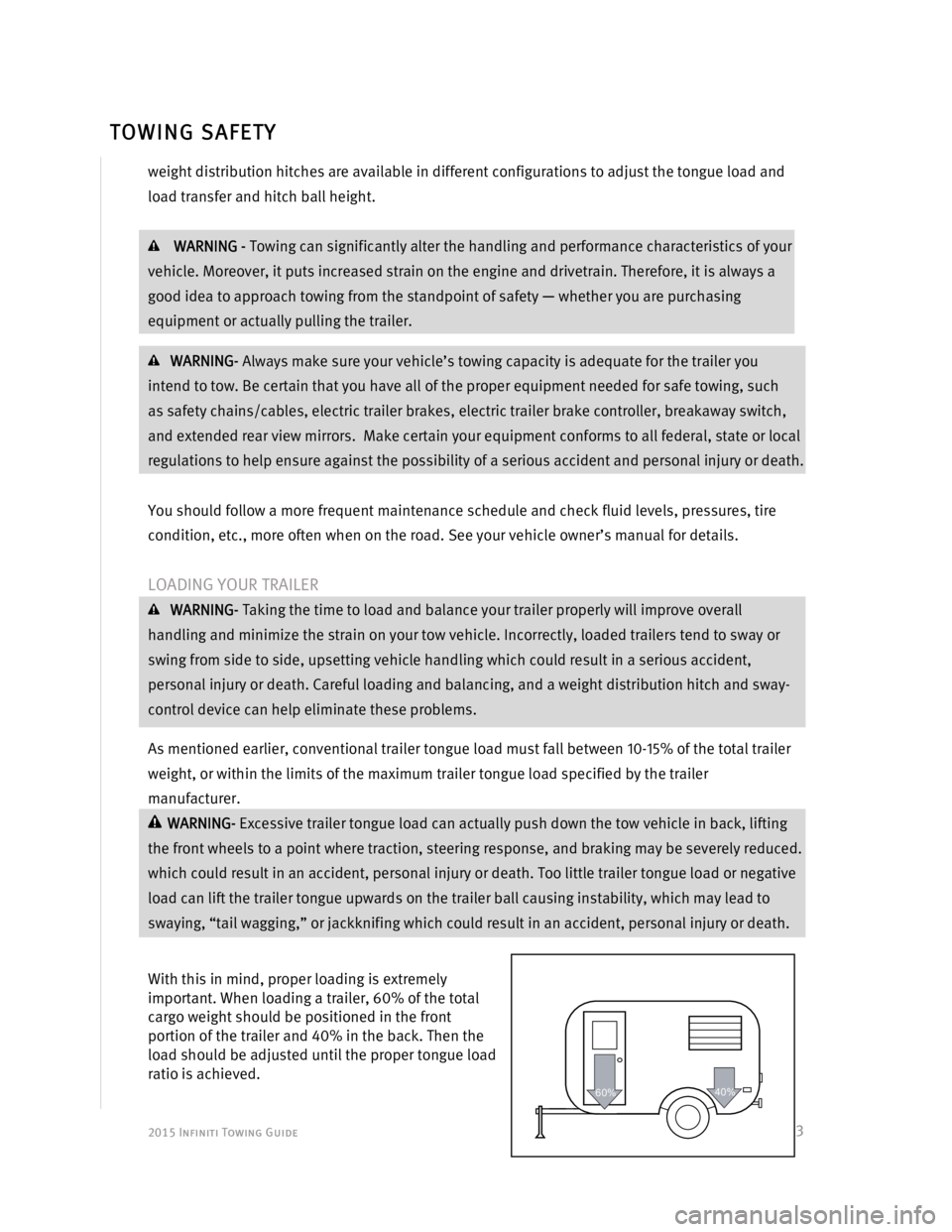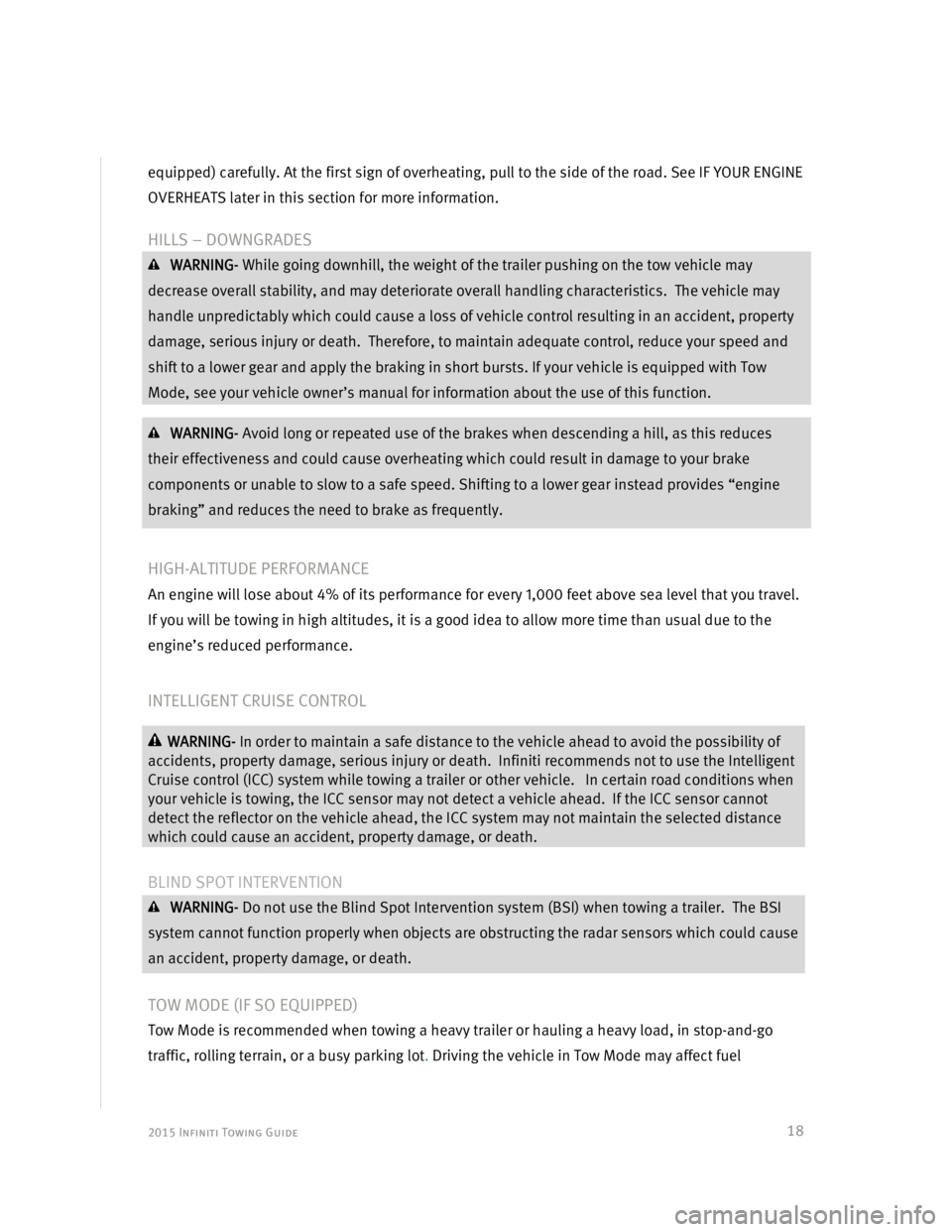weight INFINITI QX80 2015 Towing Guide
[x] Cancel search | Manufacturer: INFINITI, Model Year: 2015, Model line: QX80, Model: INFINITI QX80 2015Pages: 25, PDF Size: 0.42 MB
Page 13 of 25

2015 Infiniti Towing Guide
12 The GCW you come up with must not exceed the Gross Combined Weight Rating (GCWR) for your
vehicle. Refer to your vehicle owner’s manual to view the maximum GCWR specification listed for
your vehicle.
TRAILER TONGUE LOAD
Trailer tongue load is the amount of
trailer’s weight pressing down on the
tow vehicle hitch ball.
To measure trailer tongue load, place
the tongue of the trailer on a scale
when the trailer is not attached to the
vehicle. A separate vehicle jack — not
the trailer jack — should be used, as
the location of the trailer jack is rearward of the trailer tongue and will not give you an accurate
measurement of the true tongue load. Make sure the vehicle jack is placed directly under the trailer
tongue coupler, and the tongue is set at the height/level of the tow vehicle hitch.
For proper handling, you must keep the trailer tongue load between 10-15% of the actual trailer
weight, within the limits of the maximum trailer tongue load allowable. For example, to determine
the proper trailer tongue load for a 1,500-lb. trailer, multiply the weight of 1,500 lbs. by 10% to arrive
at a figure of 150 lbs.
Some trailer types may require different trailer tongue loads for safe towing. Always follow the
trailer manufacturer’s recommendations for proper trailer set-up and trailer tongue load. Keep the
trailer tongue load within the maximum trailer tongue load allowable. Additionally, make sure the
vehicle has the payload capacity available for the trailer tongue load. If the tongue load becomes
excessive, rearrange cargo to allow for proper tongue load.
Refer to your vehicle owner’s manual to view the maximum trailer tongue load listed for your
vehicle.
HITCH & TRAILER HEIGHT
It is important that your trailer floor and
tongue ride as level as possible. This
will help prevent over-angling, bottoming-out,
and improper tongue load and load transfer.
Therefore, the hitch or trailer tongue must be
adjusted during the initial vehicle/trailer fit-
up to ensure a level ride. Ball mounts and
Trailer Tongue Load
Total Trailer Loadx 100 = 10-15%
Vehicle
Jack
Trailer Tongue Load
Total Trailer Load
Page 14 of 25

2015 Infiniti Towing Guide
13
weight distribution hitches are available in different configurations to adjust the tongue load and
load transfer and hitch ball height.
WARNING - Towing can significantly alter the handling and performance characteristics of your
vehicle. Moreover, it puts increased strain on the engine and drivetrain. Therefore, it is always a
good idea to approach towing from the standpoint of safety — whether you are purchasing
equipment or actually pulling the trailer.
WARNING- Always make sure your vehicle’s towing capacity is adequate for the trailer you
intend to tow. Be certain that you have all of the proper equipment needed for safe towing, such
as safety chains/cables, electric trailer brakes, electric trailer brake controller, breakaway switch,
and extended rear view mirrors. Make certain your equipment conforms to all federal, state or local
regulations to help ensure against the possibility of a serious accident and personal injury or death.
You should follow a more frequent maintenance schedule and check fluid levels, pressures, tire
condition, etc., more often when on the road. See your vehicle owner’s manual for details.
LOADING YOUR TRAILER
WARNING- Taking the time to load and balance your trailer properly will improve overall
handling and minimize the strain on your tow vehicle. Incorrectly, loaded trailers tend to sway or
swing from side to side, upsetting vehicle handling which could result in a serious accident,
personal injury or death. Careful loading and balancing, and a weight distribution hitch and sway-
control device can help eliminate these problems.
As mentioned earlier, conventional trailer tongue load must fall between 10-15% of the total trailer
weight, or within the limits of the maximum trailer tongue load specified by the trailer
manufacturer.
WARNING- Excessive trailer tongue load can actually push down the tow vehicle in back, lifting
the front wheels to a point where traction, steering response, and braking may be severely reduced.
which could result in an accident, personal injury or death. Too little trailer tongue load or negative
load can lift the trailer tongue upwards on the trailer ball causing instability, which may lead to
swaying, “tail wagging,” or jackknifing which could result in an accident, personal injury or death.
With this in mind, proper loading is extremely
important. When loading a trailer, 60% of the total
cargo weight should be positioned in the front
portion of the trailer and 40% in the back. Then the
load should be adjusted until the proper tongue load
ratio is achieved.
60%40%
TOWING SAFETY
Page 15 of 25

2015 Infiniti Towing Guide
14
WARNING-The trailer load should be balanced
equally from side-to-side. Unequal side-to-side
loading can negatively affect handling and
braking. Once in place, all cargo should be firmly
secured to prevent shifting. If the load should shift
abruptly during braking or cornering, it could
adversely affect the handling of your vehicle and
cause a very unsafe situation and may lead to an
accident or personal injury.
● DO NOT carry flammable materials, such as
gasoline, in your trailer. In the event of an accident,
an explosion or fire could occur.
PROVIDING FOR VEHICLE/TRAILER STABILITY
WARNING- Improper loading, excessive or insufficient trailer tongue load, overloading,
excessive trailer weight, poorly designed trailer suspensions, crosswinds, and poor maintenance
are all things that can affect the stability of your vehicle and trailer combination. Overloading or
unsafe operating conditions could lead to a serious accident, personal injury or death.
If swaying occurs, gradually reduce speed, and apply only the trailer brakes to help reduce sway.
Steady the steering wheel and gradually pull over and stop to check the cargo load for proper
balance and distribution to ensure proper trailer tongue load. In addition, check the condition of
the suspension and shocks, as well as the tires, tire pressures, and wheel bearings on both the tow
vehicle and trailer.
If the swaying continues and your trailer is suitably balanced and within the towing capacity limits
of your vehicle, discontinue towing and consult your Infiniti retailer or trailer manufacturer to
determine the problem.
VEHICLE SPEED
Please note that some states have specific regulations and speed limits for vehicles that are towing
trailers. Remember to reduce your speed in unsafe or less-than-ideal road conditions or weather.
When towing a trailer, braking distances increase while handling agility decreases. Always leave
yourself an extra margin of distance to respond to emergencies.
Page 18 of 25

2015 Infiniti Towing Guide
17
Of course, backing up should be done only at very slow speeds. For large trailers that obstruct your
rearward vision, have someone outside the vehicle act as a “spotter” to guide you along.
WARNING- Do not use the Back-up Collision Intervention system (BCI) when towing a trailer. The
BCI system cannot function properly when objects are obstructing the radar sensor beams.
PARK SMART
A tow vehicle and trailer can be an unwieldy combination in a small area, so always try to park
where you will have a relatively easy time maneuvering. Once parked, always block the wheels on
both the tow vehicle and the trailer.
Parking on a slope is not recommended. If, however, you must park on a slope and your vehicle is
equipped with an automatic transmission, there are some precautions you should take:
Turn the wheels of the tow vehicle towards the side of the road away from the center of the road,
and apply the parking brake and only then move the gear lever into PARK.
Next, have someone block the wheels once the tow vehicle and trailer are in position and are
being held by the vehicle’s brake.
CAUTION-If you move the lever into PARK before blocking the wheels and applying the parking
brake, it may be difficult to later shift out of PARK. Transmission damage may also occur.
PASS CAREFULLY
As mentioned in the introduction to this section, because of the added weight of the trailer,
acceleration capability is reduced and you will require a longer distance to pass another vehicle. Be
certain you have sufficient time and space to pass safely.
WARNING- Never attempt to pass on hills or when going around curves. Doing so could cause a
loss of vehicle control and result in accident, property damage or personal injury. Because the
trailer does not follow the exact path as the tow vehicle on turns, safely passing and cornering
while towing takes considerably more distance and turning space than normal. Be certain you
have sufficient time and space to pass safely, remember, the length of the trailer must also pass
the other vehicle before you can safely change lanes.
HILLS – UPGRADES
If your vehicle is equipped with an automatic transmission, it is designed to select automatically
the correct gear for the best towing comfort and performance as the incline increases. To maintain
speed or avoid up and down shifts, manually shift to a lower gear as needed.
The added weight of a trailer places an increased load on the engine and cooling system, so
monitor your coolant temperature gauge and automatic transmission fluid temperature gauge (if
Page 19 of 25

2015 Infiniti Towing Guide
18
equipped) carefully. At the first sign of overheating, pull to the side of the road. See IF YOUR ENGINE
OVERHEATS later in this section for more information.
HILLS – DOWNGRADES
WARNING- While going downhill, the weight of the trailer pushing on the tow vehicle may
decrease overall stability, and may deteriorate overall handling characteristics. The vehicle may
handle unpredictably which could cause a loss of vehicle control resulting in an accident, property
damage, serious injury or death. Therefore, to maintain adequate control, reduce your speed and
shift to a lower gear and apply the braking in short bursts. If your vehicle is equipped with Tow
Mode, see your vehicle owner’s manual for information about the use of this function.
WARNING- Avoid long or repeated use of the brakes when descending a hill, as this reduces
their effectiveness and could cause overheating which could result in damage to your brake
components or unable to slow to a safe speed. Shifting to a lower gear instead provides “engine
braking” and reduces the need to brake as frequently.
HIGH-ALTITUDE PERFORMANCE
An engine will lose about 4% of its performance for every 1,000 feet above sea level that you travel.
If you will be towing in high altitudes, it is a good idea to allow more time than usual due to the
engine’s reduced performance.
INTELLIGENT CRUISE CONTROL
WARNING- In order to maintain a safe distance to the vehicle ahead to avoid the possibility of
accidents, property damage, serious injury or death. Infiniti recommends not to use the Intelligent
Cruise control (ICC) system while towing a trailer or other vehicle. In certain road conditions when
your vehicle is towing, the ICC sensor may not detect a vehicle ahead. If the ICC sensor cannot
detect the reflector on the vehicle ahead, the ICC system may not maintain the selected distance
which could cause an accident, property damage, or death.
BLIND SPOT INTERVENTION
WARNING- Do not use the Blind Spot Intervention system (BSI) when towing a trailer. The BSI
system cannot function properly when objects are obstructing the radar sensors which could cause
an accident, property damage, or death.
TOW MODE (IF SO EQUIPPED)
Tow Mode is recommended when towing a heavy trailer or hauling a heavy load, in stop-and-go
traffic, rolling terrain, or a busy parking lot. Driving the vehicle in Tow Mode may affect fuel
Page 21 of 25

2015 Infiniti Towing Guide
20
6. If no leaks are apparent and all other components appear to be operating properly with the
engine cooled to its normal operating temperature; check the coolant level in the reservoir
tank with the engine running. Add coolant to the reservoir tank if needed. At this point, if
repairs are required, go to the nearest Infiniti retailer. See the IN CASE OF EMERGENCY
section of your vehicle owner’s manual for additional information on overheating.
NOTE – All Infiniti vehicles have an engine protection mode which helps reduce the chance of
engine damage if the engine coolant reaches a specified temperature.
NOTES
Passenger Vehicles – Infiniti does not recommend trailer towing with Q50, Q60 (Coupe,
Convertible), Q70, or Q70 (HEV) vehicles.
Cross-Over Vehicles – Infiniti
does not recommend trailer towing with QX50, or the QX70 2WD vehicles.
Other Recommendations and Information – Towing performance and speed are affected by vehicle
payload, tow weight, road grades, and weather conditions, including high temperatures. See your
vehicle owner’s manual for details.
1 Maximum Trailer Weight values are calculated assuming a base vehicle with
driver and any options required, to achieve the rating. Additional
passengers, cargo and/or optional equipment will add weight to the vehicle
and reduce your vehicle’s maximum towing capacity and trailer tongue
load.
2 In general, a weight-distributing hitch system should be used when towing
over 5,000 lbs.
3 Most states require a separate braking system on trailers with a loaded
weight above a specific amount. Check local ordinances. 7-pin connector
trailer wire harnesses are required for use with trailer brakes (available
separately).
Page 22 of 25

2015 Infiniti Towing Guide
21
TOWING GLOSSARY
BALL MOUNT A bar that holds the hitch ball and is inserted into the hitch receiver. Also
commonly called a drawbar.
BREAKAWAY SWITCH A safety device using a trailer battery that automatically applies the trailer’s
brakes if it should accidentally become separated from the tow vehicle. A
breakaway switch may be used with both electric or surge trailer brake systems.
BUMPER HITCH A reinforced bumper designed to accommodate a hitch ball.
ELECTRIC TRAILER BRAKES When the brakes on a tow vehicle are applied, an electric current is sent to an
actuator which applies the trailer’s brakes.
ELECTRIC TRAILER BRAKE CONTROLLER A device that controls the electric trailer brakes.
GROSS AXLE WEIGHT RATING (GAWR) The maximum amount of weight each vehicle axle (front and rear) is designed to
safely carry.
GROSS COMBINED WEIGHT RATING (GCWR) The maximum allowable combined weight of the vehicle and trailer, including
passengers and all cargo.
GROSS VEHICLE
WEIGHT RATING (GVWR) The maximum allowable weight of the vehicle, including passengers, cargo, fuel,
hitch, trailer tongue load, and any optional equipment.
HITCH BALL
A ball that connects the trailer to the tow vehicle hitch that provides the means
by which the trailer pivots during cornering. Available in a number of sizes and
weight capacities, it must correspond to the trailer coupler size, and have a
sufficient capacity rating for the trailer being pulled.
RECEIVER HITCH A frame- or structure-mounted hitch with a receiver that allows removal of the ball
mount.
SAFETY CHAINS/CABLES Provides an emergency connection between the tow vehicle and the trailer,
should the trailer become disengaged for any reason.
SURGE BRAKES
Hydraulic-type braking system activated by inertia. As the tow vehicle begins to
brake, the trailer pushes against the hitch ball, consequently activating the trailer
brakes.
TRAILER TONGUE/COUPLER The part of the trailer that extends forward to meet the tow vehicle, and carries
the coupler assembly.
TRAILER TONGUE
LOAD The amount of trailer weight pressing down on the hitch.
WEIGHT-DISTRIBUTING
HITCH SYSTEM Type of hitch system that helps shift the trailer tongue weight to all trailer tires
and the tow vehicle front tires. Strongly recommended when towing trailers with a
Maximum Trailer Weight greater than 5,000 lbs.
WIRING HARNESS
Provides an electrical connection linking the tow vehicle’s electrical system to the
trailer’s system.